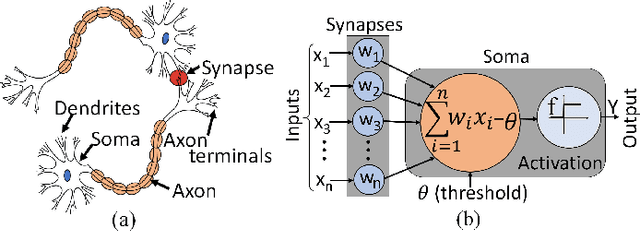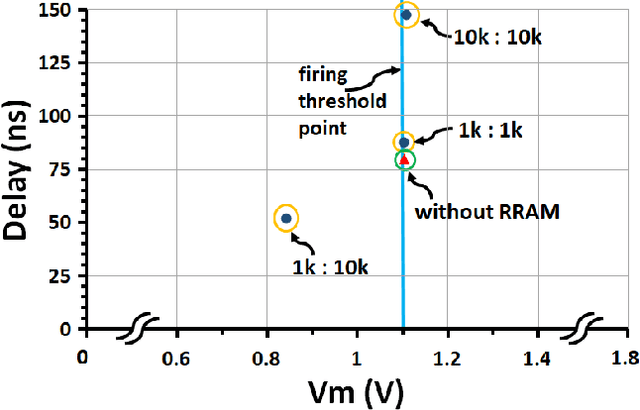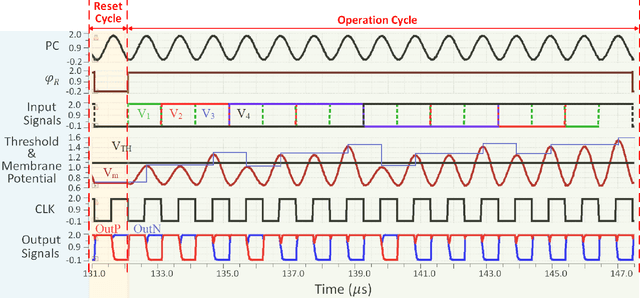Sachin Maheshwari
An Energy-Efficient Adiabatic Capacitive Neural Network Chip
Dec 16, 2025Abstract:Recent advances in artificial intelligence, coupled with increasing data bandwidth requirements, in applications such as video processing and high-resolution sensing, have created a growing demand for high computational performance under stringent energy constraints, especially for battery-powered and edge devices. To address this, we present a mixed-signal adiabatic capacitive neural network chip, designed in a 130$nm$ CMOS technology, to demonstrate significant energy savings coupled with high image classification accuracy. Our dual-layer hardware chip, incorporating 16 single-cycle multiply-accumulate engines, can reliably distinguish between 4 classes of 8x8 1-bit images, with classification results over 95\%, within 2.7\% of an equivalent software version. Energy measurements reveal average energy savings between 2.1x and 6.8x, compared to an equivalent CMOS capacitive implementation.
Adiabatic Capacitive Neuron: An Energy-Efficient Functional Unit for Artificial Neural Networks
Jul 01, 2025Abstract:This paper introduces a new, highly energy-efficient, Adiabatic Capacitive Neuron (ACN) hardware implementation of an Artificial Neuron (AN) with improved functionality, accuracy, robustness and scalability over previous work. The paper describes the implementation of a \mbox{12-bit} single neuron, with positive and negative weight support, in an $\mathbf{0.18\mu m}$ CMOS technology. The paper also presents a new Threshold Logic (TL) design for a binary AN activation function that generates a low symmetrical offset across three process corners and five temperatures between $-55^o$C and $125^o$C. Post-layout simulations demonstrate a maximum rising and falling offset voltage of 9$mV$ compared to conventional TL, which has rising and falling offset voltages of 27$mV$ and 5$mV$ respectively, across temperature and process. Moreover, the proposed TL design shows a decrease in average energy of 1.5$\%$ at the SS corner and 2.3$\%$ at FF corner compared to the conventional TL design. The total synapse energy saving for the proposed ACN was above 90$\%$ (over 12x improvement) when compared to a non-adiabatic CMOS Capacitive Neuron (CCN) benchmark for a frequency ranging from 500$kHz$ to 100$MHz$. A 1000-sample Monte Carlo simulation including process variation and mismatch confirms the worst-case energy savings of $\>$90$\%$ compared to CCN in the synapse energy profile. Finally, the impact of supply voltage scaling shows consistent energy savings of above 90$\%$ (except all zero inputs) without loss of functionality.
An Adiabatic Capacitive Artificial Neuron with RRAM-based Threshold Detection for Energy-Efficient Neuromorphic Computing
Feb 02, 2022



Abstract:In the quest for low power, bio-inspired computation both memristive and memcapacitive-based Artificial Neural Networks (ANN) have been the subjects of increasing focus for hardware implementation of neuromorphic computing. One step further, regenerative capacitive neural networks, which call for the use of adiabatic computing, offer a tantalising route towards even lower energy consumption, especially when combined with `memimpedace' elements. Here, we present an artificial neuron featuring adiabatic synapse capacitors to produce membrane potentials for the somas of neurons; the latter implemented via dynamic latched comparators augmented with Resistive Random-Access Memory (RRAM) devices. Our initial 4-bit adiabatic capacitive neuron proof-of-concept example shows 90% synaptic energy saving. At 4 synapses/soma we already witness an overall 35% energy reduction. Furthermore, the impact of process and temperature on the 4-bit adiabatic synapse shows a maximum energy variation of 30% at 100 degree Celsius across the corners without any functionality loss. Finally, the efficacy of our adiabatic approach to ANN is tested for 512 & 1024 synapse/neuron for worst and best case synapse loading conditions and variable equalising capacitance's quantifying the expected trade-off between equalisation capacitance and range of optimal power-clock frequencies vs. loading (i.e. the percentage of active synapses).
 Add to Chrome
Add to Chrome Add to Firefox
Add to Firefox Add to Edge
Add to Edge